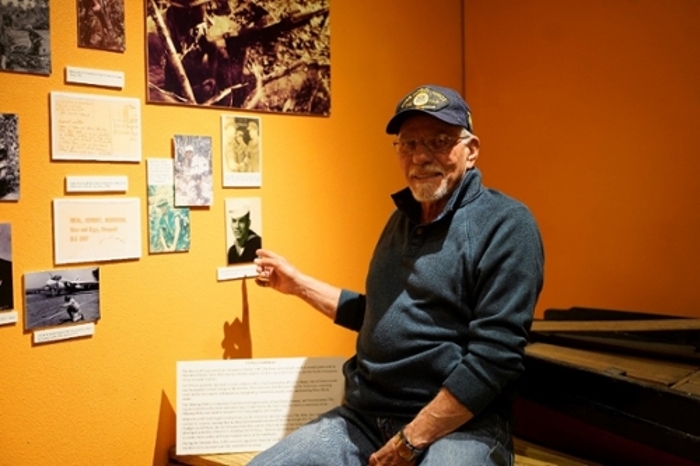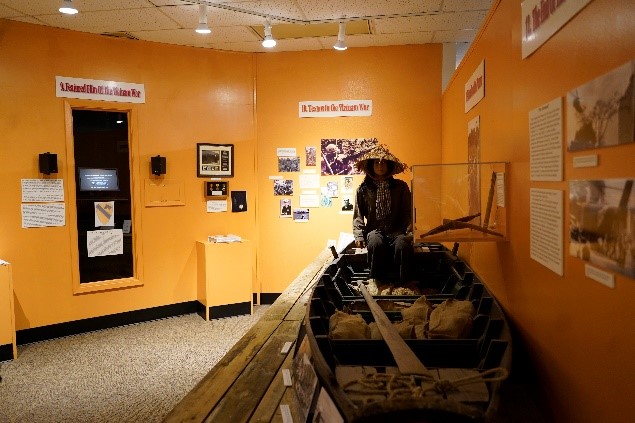Vietnam Veteran of Godley donated Swift Boat information to Texas Heritage Museum
Robin DeMott
Friday, August 30, 2019 4:00 PM
Texas Heritage Museum
Hillsboro, TX
The Texas Heritage Museum received a donation from Vietnam Veteran Harold “Randy” Beard from Godley who served in the U.S. Navy on swift boats from 1966-1967.
“I felt in my heart it needed to be here in this museum. It is the only museum I’ve found that exhibits the River Forces of Vietnam and the Coast Guard,” says Beard. He worked on a swift boat, 50 feet long and made of aluminum. He donated a 53-year-old newspaper clipping with a picture of the boat he blew up on Feb. 14, 1966.
“The enemy sank one of our boats and we lost seven men in my outfit,” said Beard of his experience.
He was a part of the PBR (Patrol Boat River). He trained in Coronado, Colo. A typical crew consisted of five enlisted men, one officer on one boat, approximately 10 ft. wide and 50 ft. long. Beard was born in Delhardt, raised in Coleman and now lives in Godley.
The first swift boats arrived in Vietnam in October 1965. The boats were initially used as coastal patrol craft in Operation Market Time, intercepting seaborne supplies on their way to the Viet Cong and the North Vietnamese Army in South Vietnam.
Swift boats generally operated in teams of three to five. Each boat had an officer in charge, one of whom would also be placed in overall charge of the mission. Their mission included patrolling the waterways, searching water traffic for weapons and munitions, transporting Vietnamese Marine units, and inserting Navy SEAL teams.
The Mekong Delta is composed of 10,000 square miles of marshland, swamps and forested areas. The region is interlaced by rivers and canal ways. Controlled by Viet Cong, the interior waterways of the Mekong Delta were used to transport Viet Cong supplies and weapons.
When the swift boats began making forays up the waterways into the interior of the delta, they initially took the carriers by surprise, causing them to drop their materials and run off in the overgrowth. Occasionally, a short firefight would break out. As it became clear that control of the waterways was being contested, the Viet Cong developed a number of tactics to challenge the U.S. Navy. They set up ambushes, built obstructions in the canals to create choke points, and began to place mines in the waterways.
During the Vietnam War, 3,600 soldiers served or supported America’s swift boat mission. Four hundred service members were wounded and 50 were killed in action.
The Texas Heritage Museum serves an active and successful role in the educational and service missions of Hill College; and brings increasing national and international prestige to Hill College. The Texas Heritage Museum is comprised of three divisions: Galleries & Collections, Historical Research Center, and the Hill College Press. Furthermore, on the front of the museum grounds is the Home of the Official Texas State Medal of Honor Memorial to Native-Born Texans.
The Texas Heritage Museum's mission is "To explore Texas and Texans during wartime and how those experiences affect us today." This mission statement is divided into two parts. Part one of the mission states "To explore Texas and Texans during wartime…," and the Texas Heritage Museum showcases Texans in war. The second part of the mission states "…how those experiences affect us today," and the museum tries to concisely capture the visitors’ experiences with its exhibits and programs.
The Museum is free and open to the public. The hours of operation are Monday through Thursday, 8 a.m. to 4:30 p.m. and Fridays 8 a.m.-4 p.m.
Vietnam Veteran Harold “Randy” Beard of Godley pictured with the artifacts on display in the Vietnam Exhibit at the Texas Heritage Museum.

Photo cutline: Vietnam War Swift Boat exhibit.
